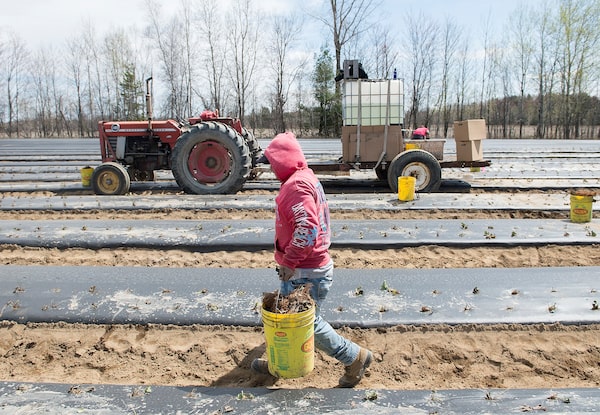
A temporary foreign worker from Mexico is shown on a berry farm in Mirabel, Que., on May 6, 2020.Graham Hughes/The Canadian Press
Canadian companies ramped up their recruitment of temporary foreign workers last year, even as the labour market softened and the unemployment rate drifted higher.
During the last quarter of 2023, employers were approved to fill more than 81,000 positions through the Temporary Foreign Worker Program, according to figures shared by the federal government with The Globe and Mail. It was easily the largest quarter for approvals since Ottawa made several employer-friendly changes to the program in the spring of 2022.
For the year, employers were approved to fill roughly 240,000 job vacancies, an increase of 7.5 per cent from 2022 – and more than double what was permitted in 2018.
The federal government is now trying to clamp down on temporary migration to the country with various changes that include tighter restrictions on the TFW program. Immigration Minister Marc Miller has said that Canadian companies have become “addicted” to temporary foreign labour.
“Let me be clear, the Temporary Foreign Worker Program is a last resort,” Employment Minister Randy Boissonnault said at a news conference last month. “Employers should not use the Temporary Foreign Worker Program as a means to avoid offering competitive wages to Canadians.”
More than half of TFW approvals in the fourth quarter came from the program’s agriculture streams, with employers getting ready for seasonal work this summer. Many of those companies are looking for general farm and greenhouse workers to harvest fruits and vegetables.
Still, there has been a broad-based increase in use of the TFW program, including from its low-wage stream. Over the past two years, employers have increased their recruitment of cooks, retail clerks and cleaners paid low hourly wages, among other occupations in high demand.
For example, Joh2Stone Inc. – the operator of several McDonald’s Corp. franchises in Eastern Ontario – was approved in the fourth quarter to fill 78 food-service roles. Many Tim Hortons franchises also received approvals.
Ottawa to rein in number of temporary residents and announce targets in the fall
The federal government broadened access to temporary foreign workers in April, 2022, through a mix of temporary and permanent measures aimed at helping employers that were struggling to find new hires. After the early devastation of the COVID-19 pandemic, the Canadian labour market became exceptionally tight – the unemployment rate hit a low of 4.8 per cent in the summer of 2022 – leading to fierce competition to fill vacancies.
A handful of hard-hit industries, such as accommodation and food services, were temporarily permitted to hire up to 30 per cent of their staff through the low-wage stream of the TFW program, up from a previous 10 per cent cap. Most other industries were permanently bumped up to 20 per cent.
Last month, Ottawa announced several changes to the program, including that a few industries, such as accommodation and food services, would move down to the 20 per cent cap, effective May 1.
“This still exceeds the 10 per cent limit that existed before 2022 and the health care and construction industries are exempted,” wrote the economists Mikal Skuterud and Parisa Mahboubi on the website of the C.D. Howe Institute, a think tank. “Admissions of low-wage TFWs are always a problem when local unemployment rates are rising.”
Indeed, Canada’s labour market is softening amid higher interest rates. The national unemployment rate has risen to 6.1 per cent, as of March, up a full percentage point from a year earlier. Employers are still creating jobs, but not enough to match the pace of strong population growth.
Alongside the TFW changes, the federal government announced in March that it will reduce temporary residents to 5 per cent of the total population over the next three years. At last count, there were nearly 2.7 million temporary residents in Canada, or 6.5 per cent of the total population.
People employed through the TFW program amount to a small portion of temporary residents. The group is largely comprised of international students and people here on work permits through other programs.
Several economists have criticized the government for loosening rules in the TFW program. They’ve expressed concerns about wage suppression and the potential for foreign workers to be exploited, because their permits are tied to a single employer. (Migrant workers who face abuse, or are at risk of abuse, can apply for an open work permit, but they must provide sufficient evidence of misconduct to the government.)
“I think the abuses that we see in the program would be quickly solved if we had open work permits,” said Catherine Connelly, a professor at McMaster University and the author of Enduring Work: Experiences with Canada’s Temporary Foreign Worker Program. “Because the workers who experience mistreatment, it starts out small enough. … It would be really nice if they could quit and work somewhere else before something terrible happens to them.”
The TFW approval numbers come from Employment and Social Development Canada, which assesses employer applications to use the program. Employers must demonstrate that they can’t find local workers to fill the positions in question. The ESDC numbers reflect the first part of the hiring process; after the employer is approved, foreign workers must get the requisite permits to begin their jobs in Canada.
By the end of 2023, foreign workers held roughly 189,000 permits through the TFW program – more than quadrupling from 2017, according to figures from the federal immigration department.
For her book, Dr. Connelly spoke with business owners who use the TFW program. Many of them did so for legitimate reasons, she said, because they were based in remote areas or needed specialized skills.
But there were other businesses, such as fast-food outlets in urban areas, that also tapped the program for labour.
“There’s no need to hire someone from far away” in those cases, she said.
 Matt Lundy
Matt Lundy